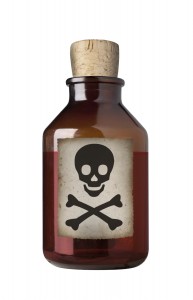 When Dave Galvin talks about why we need to manage hazardous waste from houses and small businesses, he sometimes holds up a tiny bottle of rat poison. It’s 100% arsenic.
When Dave Galvin talks about why we need to manage hazardous waste from houses and small businesses, he sometimes holds up a tiny bottle of rat poison. It’s 100% arsenic.
When people talk about Dave’s presentations, they are likely to mention the tiny of bottle of arsenic. They may not remember much else about his presentation, but they remember that. It’s concrete.
Dave is the manager of King County’s Hazardous Waste Management Program, so it’s not unusual for him to speak in public. He could (and sometimes does) spout facts and figures, budgets and statistics. But the bottle of arsenic has an impact far beyond its size.
The third chapter of Chip and Dan Heath’s book “Made to Stick” is titled “Concrete.” They describe some teaching examples, such as using stick figures of kids playing ball to teach arithmetic or using a case study to teach college accounting. Learning is easier if abstract concepts are connected to things that are concrete.
When I worked in the Hazardous Waste Program, I remember a time that our budget person came to the work site to teach us about the King County budget. She brought a tall stack of budget documents and set them on a table. Then she set down a small sheaf of stapled sheets.
She said, “I could go through this pile of documents and explain all the steps in putting together the county’s budget. Or I could hand out these sheets and you could role play the different departments and divisions having to craft a budget.”
Not surprisingly, the group voted to do the role play. At the end of the exercise, I had a clearer sense of the constraints and tradeoffs that go into creating a budget for county government.
Having concrete goals helps teams do more effective work. “Made to Stick” talks about when Boeing was launching the design of the 727 passenger jet in the 1960s. The goal was deliberately concrete: The 727 must:
- Seat 131 passengers
- Fly nonstop from Miami to New York City
- Land on Runway 4-22 at La Guardia (shorter than what existing jets could handle).
The concrete goal enabled thousands of engineers to work on various aspects of the plane’s design and manufacturing. As the Heath brothers said, “Imagine how much harder it would have been to build a 727 whose goal was to be ‘the best passenger plane in the world.'”